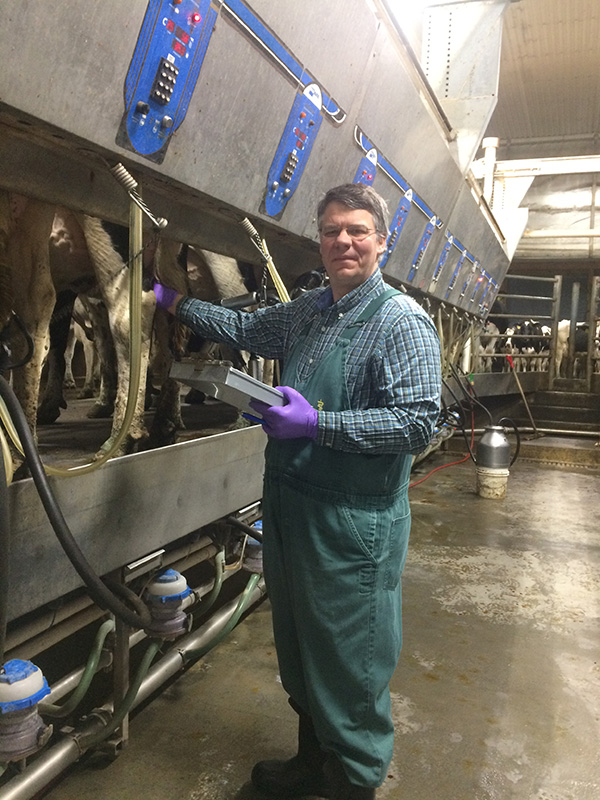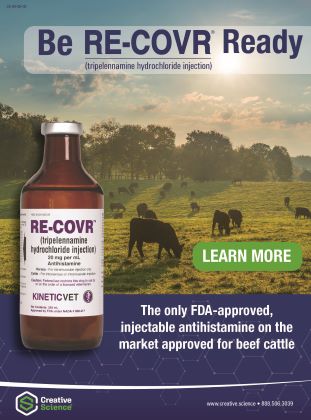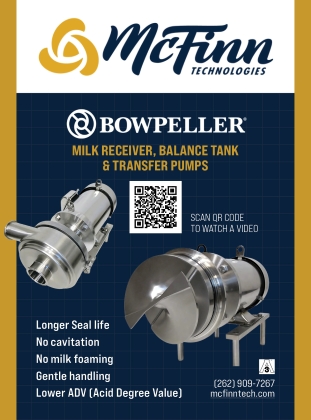Milk Testing and Milk Grades

By Heather Smith Thomas
Dairies routinely have their milk tested to make sure it does not contain harmful levels of bacteria, and will retain high quality. There are also a number of other tests that can be done, to help dairymen monitor the health and production of their cows.
Amy Vasquez, DVM PhD, Assistant Professor at Cornell University where a lot of milk testing is done says part of her job is providing Extension services for Quality Milk Production Services (QMPS) as part of the health diagnostic lab on campus. “At QMPS we work closely with farms to address milk quality concerns. Most of the testing is done here at the laboratory but we also do equipment testing on farms, observing the milking technicians and their practices. In the lab we mainly do bacterial analyses, determining which bacteria are present in the individual milk samples submitted, as well as bulk tank samples,” she says.
“We do screening for certain pathogens in bulk tanks and for specific pathogens in individual cows. We also do surveys; if a dairy wants a snapshot of the health of all animals on the farm we can provide technicians to sample all the cows and run bacterial cultures on those samples to determine whether those cows have subclinical infections,” says Vasquez.
“We also do bacterial cultures of water samples, bedding samples, etc. Some dairies submit the towels they clean cows with. If they are worried that their laundering processes for the towels are not effective at removing all the bacteria, they can submit towel samples and we can determine the bacterial load before they use those,” she says.
The diagnostic labs at QMPS have websites that list the various things they do. “Here in New York, we also have three satellite labs. The main lab is here in Ithaca and we have regional labs in Cobleskill, Kenton, and Warsaw. All of them have courier routes; someone drives a route on a daily basis from here and maybe less frequently from the other labs to pick up milk samples from the herds we serve. If the large herds have samples they want tested daily we have someone who picks them up,” she says.
Veterinarians are employed at each of the regional labs as well as the Ithaca lab and they can go out with the technicians to help troubleshoot issues on various farms. “We write reports for those farms when we finish our investigations.”
Milk testing is complicated because there are some required tests for regulatory requirements, and also some voluntary requirements. “Grade A dairy producers have to follow the Pasteurized Mild Ordinance (PMO), a government requirement. These are outlined in the PMO; dairies can’t ship milk that has bacterial counts over 100,000 cfu per ml (colony-forming units per milliliter, a measure of the number of viable bacterial cells in a liquid sample), and somatic cell count not over 750,000 per ml. Then it is up to the individual state regarding how they monitor farms for those requirements.”
In New York, one bulk tank sample must be taken from every Grade A dairy each month to determine whether the dairies are meeting the PMO guidelines. “If they are not, there are certain things those farms must do until they can meet these. For instance, if they have 2 out of 4 months of high bacterial counts, their next tank of milk cannot be picked up unless it is lower than the 100,000 bacterial count. If the somatic cell count is over 750,000 cells/ml on this sample, they get a warning, a second high sample requires them to enroll in a QMPS evaluation; the dairy must coordinate payment for sampling each of their cows, to help guide them on how to get their counts down. They must remain enrolled in this program until 3 out of 4 consecutive official samples prove compliance, otherwise the milk truck is not allowed to pick up their milk,” she says.
Milk that can’t be picked up can be dumped, or sold to a nearby calf ranch to feed calves—and recommended that the calf ranch pasteurize the milk. “They might be able to sell it to a different market that’s not a grade A market, if a local processor uses Grade B milk, but the dairy would take a hit on the price,” says Vasquez.
Antibiotic residues are another issue. Certified laboratories and milk plants test for beta lactam, the penicillin types of antibiotic. Some people are allergic to penicillin so there can be no residues in milk.
“A processor can have its own requirements, beyond the PMO. Milk companies have requirements for what they are willing to accept. They can test for some of those things at their own factory gate. For instance when milk arrives at a DFA (Dairy Farmers of America) plant, they test it for additional things. If the milk doesn’t meet their stricter threshold, they won’t take that milk. They may put a stricter threshold on bacterial counts or somatic cell count. Companies that do European trade must meet a somatic cell count limit of 400,000 cells/ml. Some processors, if a tanker load shows up and we test it and it’s over 400,000 cells/ml, they won’t accept it,” she says.
“Some plants also test for other types of antibiotics, beyond the beta lactams. Some test for sulfa drugs and tetracycline. This is up to the processor. Individual producers may have access to tests they can use on-farm if they want to screen their own milk before shipping it to the plant.”
Some of the incentives offered by the processor to the producer depend on other bulk tank counts. “Many of the tests are not used at the factory gate or at the processing level when the milk shows up, but instead on the individual bulk tanks the driver takes when picking up milk. Some of those samples go to the plant and are analyzed for somatic cell and bacterial count to determine whether that load is accepted, but there are other samples that go to a lab and are tested for butterfat and everything the producer might get paid on. It all depends on the processor regarding whether they test every tank or just do once-a-week testing, and what they test for. Some processors are now either deducting money from the milk check or giving bonuses for things like the preliminary incubation count (PI count) and the LPC (lab pasteurization count) as well as the raw bacterial count and somatic cell count. Processors may also pay incentives to producers to keep those levels low,” she says.
Coliform bacteria are also tested for—how many E. coli organisms are in the bulk tank milk. “Low PI, LPC, and coli counts will bring bonuses if the producers are able to keep those low enough. This kind of testing is something Dairy One or ELS (Eastern Laboratory Services) might do, sending readout for those values. There are many things you can test for in milk. The focus on the processing and regulatory side and our side at QMPS is mainly on different types of bacterial counts and somatic cell counts, to help dairies improve the health of the cattle, and potential public health implications.”
Processors also offer bonuses. “You can pasteurize milk and get rid of most bacteria, and somatic cells are not actually a public health concern, but when you pasteurize you can potentially heat-stable enzymes into that milk. Though the bacteria might be gone for the most part, the enzymes start to break down the milk and cause off-flavors and decrease shelf life. Processors are learning that if you have top quality milk going into the food chain, it will last longer on the shelf and taste better if those counts are really low,” she says.
CHECKING FOR MASTITIS – Paul D. Virkler DVM, also works for QMPS. “This program has several focuses, but for testing, one of the primary focuses is to help dairy farms determine which organisms are causing mastitis. “There are two main angles to this focus. One is a pathogen-based treatment program,” he says.
“Farms take milk samples from cows with mastitis, and our courier routes pick those up. We send back the results regarding which pathogens we find. This guides the dairy’s treatment of each cow for mastitis.” The dairy can target the specific organism.
“On a typical farm, maybe a third of those samples are negative, which means the cow has already cleared it and there is no need for antibiotics. Or, if it’s an organism that doesn’t respond to antibiotics that are legal to use, they don’t treat. The herd veterinarian for the farm writes the treatment protocol. It’s the herd veterinarian’s responsibility but we provide the information and infrastructure to get the results back to the farms in a timely manner, so they can make good treatment decisions,” says Virkler.
The other part of the culture work is helping farms screen bulk tanks and screen the cows that have just calved, to check for contagious mastitis. “The dairy can be alerted if they have a contagious mastitis—and which cows. Then they can separate those cows and make sure they don’t spread it cow-to-cow,” he says.
“Overnight shipping works for samples farther away, but that puts one more day in the turnaround. The samples from local farms are more for screening for contagious mastitis, and this helps them keep it from spreading through the herd.”
QMPS also has a field services program. “We go to farms and help troubleshoot their risks for mastitis. Our veterinarians and field technicians go out to the farm and spend one milking there, looking at what’s going on with the equipment, how the people are doing the milking routine, and what’s happening with the environment. We walk through all the stalls, look at the bedding, how the cows are lying, and look at the cows and do teat scoring, etc. A person can think of this as a risk assessment for the farm, looking for the biggest areas with high risk for mastitis. We write it all up and come back and sit down with the herd veterinarian and whoever else is involved with management of the cows and have a discussion to try to figure out what they could do to reduce the risk for mastitis,” says Virkler.
“Prevention of mastitis is the biggest goal. If we can prevent it, we never have to treat it or worry about milk out of the tank, or the damage it might do to the cow’s udder. Most of our time is spent on prevention, helping dairy managers walk through how they can prevent mastitis. We usually have a farm meeting for a follow-up after we are there.”
This kind of preventative management ensures that milk is high quality and safe for human consumption. “With our pathogen-based treatment protocol, it also reduces the use of antibiotics on a farm, because we are targeting only the cows that really need it. It has been a good program and many of our farms here in New York are on it,” he says.
QMPS – Quality Milk Production Services at Cornell University is part of the Animal Health Diagnostic Center laboratory in the College of Veterinary Medicine at Cornell. It promotes milk quality by reducing mastitis levels in dairy herds–offering a variety of services including on-farm evaluations of management and equipment and whole herd milk cultures. The program’s extension veterinarians advise producers, veterinarians and milk inspectors regarding optimal practices for improving herd health and farm management.
These services make major contributions in diagnosis, control and treatment of several causes of mastitis including Streptococcus agalactiae, Staphylococcus aureus, Mycoplasma, Streptococcus spp., Staphylococcus spp. and coliform bacteria. Research continues on new methods of mastitis diagnosis, epidemiology, financial effects, non-antibiotic therapy, and bacterins.
QMPS is supported by the Department of Agriculture and Markets of New York State. As the largest organized program of its type in the world, QMPS extends services to clients in other states and other countries, utilizing the most effective methods and technology to help producers improve dairy product quality and safety. The goal is to help producers achieve greater profitability through higher milk quality and improved herd health.
The testing program started in 1946 because there was a contagious mastitis problem in the New York Governor’s dairy herd. “He called Cornell University and asked if the professors who were good at milk quality and mastitis could come to his place and determine what was going on. They came to his farm, took cultures and diagnosed Streptococcus agalactiae, a known contagious organism,” says Virkler.
Treating those cows was one of the first uses of antibiotics in cattle, just after World War II. Antibiotics were the new big thing. “Because it was the Governor’s herd, there was authorization given to try antibiotic treatment on his dairy cows. They were able to clear up the infections and help the Governor improve milk quality. He made a statement that was put into law, making this service available to all New York farms.”
At first it was called the New York State Mastitis Control Program and for 30 years operated out of the Veterinary College at Cornell. In 1975, it became a program of the Department of Agriculture and Markets and was part of the Department of Clinical Sciences in the Veterinary College. In 1986, Quality Milk came under the administrative umbrella of the Diagnostic Laboratory. It developed over the years from being mainly a diagnostic program to one with a comprehensive extension education focus designed to offer assistance to all dairies in the state in a preventive program, working closely with colleagues in the Colleges of Veterinary Medicine and Agriculture and Life Sciences in developing specific programs aimed at mastitis prevention, prevention of other diseases, and quality milk production.
“The QMPS goal is to be client focused and keep in touch with what a farm needs. It has changed a bit over the years but we service all size farms—anything from three cows to thousands of cows,” says Virkler.
In earlier days, milk grades were based on number of pathogens and somatic cell counts, and most dairies wanted to be Grade A, to receive more money for their milk. “Today most dairies are Grade A. The ones we work with are all Grade A; they all want to ship good milk,” he says.
DAIRY ONE – Christopher Lawrence, Operations Manager for the Milk Laboratories at Dairy One in Ithaca, New York, says his operation has three different departments that do milk analysis. “Our producer payment laboratory is the regulatory compliance end of the business. All tank samples from all the cooperatives and farms are tested and the results used for payment purposes. In that department we do all the bacterial analyses for aerobic bacteria, coliforms, staph aureus, etc. We also check component values—butterfat, protein, solids, milk urea nitrogen, lactose, somatic cells, freeze point depression, etc.—as well as water analysis. Anything the farm needs, to meet the regulatory standards, we provide those services within our laboratory,” he says.
“One of our other main businesses in the milk testing side is the DHI (Dairy Herd
Improvement) testing. For DHI we test about 500,000 cows per month for component values. This not only helps determine what the milk is worth but also tells the dairyman how each cow is performing, based on the feed she receives and how she’s processing that feed—and how it relates to the butterfat and protein levels. This also gives an indication of health, based on somatic cell levels,” says Lawrence. “In the past two years we also started providing fatty acid profiles. This provides another look into the genetics of the animal, rumen health, fat production, etc.
Another department is the animal health diagnostics laboratory. “In this lab we test for pregnancy, using milk and blood samples, along with disease testing. We work with other laboratories to outsource tests for BVD, leucosis, etc. In this department we also have a wet chemistry team that produces all our control standards so we can be sure that all our machines are operating properly at peak performance and giving us the most accurate data they can,” he says.
“A little more than a year ago we purchased a company called Acumen Detection, for PCR manufacturing. We brought all of that in-house as well. We’ve been creating PCR assays, targeting specific organisms that cause mastitis. One of the main ones we’ve been working on and selling a lot of during the past year is the test for Mycoplasma bovis, and more recently for Staph aureus and Strep uberis, since more dairies are now looking for those organisms to try to improve the health of their herds.”
He attended a conference last September and says a lot of the talk this past year has been about the Highly Pathogenic Avian Influenza (HPAI). This has become a huge new concern. “There have been many discussions about this disease and how it’s moved so quickly through many of the herds out west, particularly Idaho and surrounding states. At this point we are not seeing as much of it here in the Northeast but for all the states we do testing for, with USDA mandates, we’ve been pulling samples and having samples tested for the HPAI virus,” says Lawrence.
Many animals, including humans, can become infected and be carriers. “It is believed that farm workers who work at more than one farm might pick something up and carry it to the next farm. This has been one of our big concerns. Movement of people onto farms is always a concern, and when things like this happen it reinforces the need for better security, and controlling the access to your animals and to your farm,” he says.
“Currently the only state we work with that is actually testing farm samples on a regular basis is Maryland. For every farm we test in that state, we send two samples a month, at least through the rest of 2025, to test for the HPAI virus.”
MILK GRADES – “Here in the Northeast, since the U.S. market has implemented EU standards, everything here is Grade A,” says Lawrence. In the past 15 to 20 years, bacterial counts and somatic cell counts have dropped. With these standards to meet, farms have become very conscientious about the quality of their milk. It’s now rare to see counts over 100,000 and most farms today are more like 20,000 to 30,000 on their standard plate counts,” he says.
“This is a big improvement but there are still some pockets of Grade B milk. This milk goes to specific processors for making cheeses, but in general the grading system we used to have (Grade A, Grade B and Grade D milk) is a thing of the past. There are times when some farms have a problem, however; something gets into their system or isn’t working quite right and they have to figure out what to do to correct it. Maybe the CIP system or the hot water heater went down and they aren’t getting the hot water they need for doing a good job of cleaning the systems,” says Lawrence.
There’s been a significant reduction in number of dairy farms in the U.S. “When I started in this business 27 years ago, there were 111,800 dairy farms. Today there’s about 25,193. That’s a huge reduction. The interesting thing is that we have about the same amount of cows that we did earlier and we’re producing more milk than we did then.” Many farms had to get bigger to stay in business, but also the breeding programs and genetics have improved and increased milk production.
“We may be at another threshold of genetic development, to determine what these animals are truly capable of producing on a daily basis.” Farms with robotic milking can readily milk a high-producing cow that needs to be milked 3 or 4 times a day, or more.
“When I look at grading of milk, I’m thinking along the lines of butterfat and protein production. These are the things that lend more to the quality of the milk than any grade that we’ve classified. I’ve looked at data in our systems; we have decades of data.
I gave a talk at the New York State Food and Safety Protection Association a couple years ago and looked at the trends of fat, protein, somatic cells, etc. over the course of 2017 to 2022, seeing a change in just that 5-year period, and in the last 2 years what those averages are. In 2022, average butterfat across 6.6 million samples that we tested was 4.02 and today we are closer to 4.5 so in the past few years the butterfat content of the milk has increased.”



